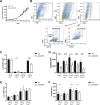The pro-tumor effect of CD200 expression is not mimicked by agonistic CD200R antibodies
- PMID: 30653571
- PMCID: PMC6336379
- DOI: 10.1371/journal.pone.0210796
The pro-tumor effect of CD200 expression is not mimicked by agonistic CD200R antibodies
Abstract
Tumor-infiltrating immune cells can impact tumor growth and progression. The inhibitory CD200 receptor (CD200R) suppresses the activation of myeloid cells and lack of this pathway results in a reduction of tumor growth, conversely a tumorigenic effect of CD200R triggering was also described. Here we investigated the role of CD200R activation in syngeneic mouse tumor models. We showed that agonistic CD200R antibody reached tumors, but had no significant impact on tumor growth and minor effect on infiltration of immune myeloid cells. These effects were reproduced using two different anti-CD200R clones. In contrast, we showed that CD200-deficiency did decrease melanoma tumor burden. The presence of either endogenous or tumor-expressed CD200 restored the growth of metastatic melanoma foci. On the basis of these findings, we conclude that blockade of the endogenous ligand CD200 prevented the tumorigenic effect of CD200R-expressing myeloid cells in the tumor microenvironment, whereas agonistic anti-CD200R has no effect on tumor development.
Conflict of interest statement
Involvement of one of the Bioceros BV does not alter authors’ adherence to PLOS ONE policies on sharing data and materials.
Figures




Similar articles
-
Antitumor Activity of TLR7 Is Potentiated by CD200R Antibody Leading to Changes in the Tumor Microenvironment.Cancer Immunol Res. 2018 Aug;6(8):930-940. doi: 10.1158/2326-6066.CIR-17-0454. Epub 2018 Jul 18. Cancer Immunol Res. 2018. PMID: 30021725
-
A Critical Role for CD200R Signaling in Limiting the Growth and Metastasis of CD200+ Melanoma.J Immunol. 2016 Aug 15;197(4):1489-97. doi: 10.4049/jimmunol.1600052. Epub 2016 Jul 6. J Immunol. 2016. PMID: 27385779 Free PMC article.
-
CD200-CD200R signaling suppresses anti-tumor responses independently of CD200 expression on the tumor.Oncogene. 2012 Jun 14;31(24):2979-88. doi: 10.1038/onc.2011.477. Epub 2011 Oct 24. Oncogene. 2012. PMID: 22020332
-
CD200-CD200R Pathway in the Regulation of Tumor Immune Microenvironment and Immunotherapy.Adv Exp Med Biol. 2020;1223:155-165. doi: 10.1007/978-3-030-35582-1_8. Adv Exp Med Biol. 2020. PMID: 32030689 Free PMC article. Review.
-
Is the CD200/CD200 receptor interaction more than just a myeloid cell inhibitory signal?Crit Rev Immunol. 2006;26(3):213-30. doi: 10.1615/critrevimmunol.v26.i3.20. Crit Rev Immunol. 2006. PMID: 16928187 Free PMC article. Review.
Cited by
-
Optimizing NK Cell-Based Immunotherapy in Myeloid Leukemia: Abrogating an Immunosuppressive Microenvironment.Front Immunol. 2021 Jun 17;12:683381. doi: 10.3389/fimmu.2021.683381. eCollection 2021. Front Immunol. 2021. PMID: 34220833 Free PMC article. Review.
-
CD200R1 promotes interleukin-17 production by group 3 innate lymphoid cells by enhancing signal transducer and activator of transcription 3 activation.Mucosal Immunol. 2023 Apr;16(2):167-179. doi: 10.1016/j.mucimm.2023.01.001. Epub 2023 Jan 7. Mucosal Immunol. 2023. PMID: 36623588 Free PMC article.
-
CD200Rhigh neutrophils with dysfunctional autophagy establish systemic immunosuppression by increasing regulatory T cells.Cell Mol Immunol. 2024 Apr;21(4):349-361. doi: 10.1038/s41423-024-01136-y. Epub 2024 Feb 5. Cell Mol Immunol. 2024. PMID: 38311677 Free PMC article.
-
Combination CD200R/PD-1 blockade in a humanised mouse model.Immunother Adv. 2023 Mar 30;3(1):ltad006. doi: 10.1093/immadv/ltad006. eCollection 2023. Immunother Adv. 2023. PMID: 37082107 Free PMC article.
-
JAM3: A prognostic biomarker for bladder cancer via epithelial-mesenchymal transition regulation.Biomol Biomed. 2024 Feb 23;24(4):897-911. doi: 10.17305/bb.2024.9979. Biomol Biomed. 2024. PMID: 38400838 Free PMC article.
References
-
- Hoek RM, Ruuls SR, Murphy CA, Wright GJ, Goddard R, Zurawski SM, et al. Down-regulation of the macrophage lineage through interaction with OX2 (CD200). Science. 2000;290: 1768–1771. - PubMed
Publication types
MeSH terms
Substances
LinkOut - more resources
Full Text Sources

